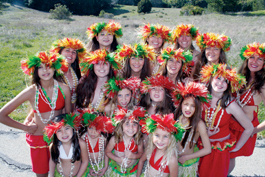home | metro santa cruz index | the arts | dance | review

Hello, Halau: Lorraine Kinnamon's hula halau, or school, celebrates 10 years this weekend.
Lovely Hula Hands
Santa Cruz's Te Hau Nui celebrates 10 years of hula on the Central Coast.
By Jaime Nabrynski
I couldn't sit still!" Lorraine Kinnamon recalls of the first time she saw the dazzling moves and pounding drums of Tahitian dance. She had just moved from Canada to Hawaii, and at 10 years old, she was deeply impressed by the mesmerizing form of Polynesian dance--so impressed that it changed her life.
During high school in Kaneohe, Oahu, Kinnamon was accepted into a dance troupe called the Sounds of Young Hawaii, which traveled the world as a sort of singing and dancing ambassadorial group. After attending UC-Santa Cruz to major in environmental studies, she reclaimed her passion for Polynesian dance. Since then she's studied with multiple kumu, or teachers, in Hawaii, Tahiti and California; it was here, in fact, that she received her Hawaiian name, "Kalehuakeaikewekiu," from acclaimed Bay Area kumu Clark Bolivar.
Intensive study eventually led to a career, and 10 years ago Kinnamon founded the Te Hau Nui Dance Company to teach hula, Tahitian and Maori poi ball dance. Though all Polynesian, the forms are as distinct from one another as can be. Hula auana (modern), which is danced to Western-influenced instruments such as slack key guitar, is the form we mostly see today. The dancers are less formal and more intimate with their audience. The movements of hula kahiko (ancient) are accompanied by more traditional instruments such as those made from bamboo sticks. Considered the most disciplined of the three island dance forms, hula is slow and partnered with chanted stories, or mele, that emphasize Hawaiian consciousness. Tahitian dancers use rapid hip movements to tease the audience to a faster, livelier drumbeat. In Maori poi ball dancing, which originated in New Zealand, the dancer manipulates a ball suspended from a long rope, swinging it in circular patterns.
Training in the company involves more than dancing. Along with learning some of the language, the dancers make their own costumes. Both are ways to take part in the traditions of the cultures in which their dances originated. Kinnamon explains that the dances and costumes are a reflection of daily life, whether what is being channeled is the tranquility of the ocean, the warmth of family or the love for a sweetheart.
"I believe that Polynesian dance is a truly spiritual practice, as well as a physical and mental one," she says. "These dancers make it look so graceful and easy, but it really is a result of endurance, focus and discipline."
Kinnamon says "ho'ike" means to show off, and she tells us that the 10th Anniversary Ho'ike Celebration of Te Hau Nui Polynesian Dance Company is "a way to show what it is we have been working on." She describes the performance as a "gift," saying that the Santa Cruz community "has given so much support to my teaching, to the students, that this is an opportunity for us to give back a retrospective of what we have accomplished over the last 10 years."
Cheryl Kailiponi Teegarden, runner-up in the World Invitational Hula Festival of 1993, has been asked by Kinnamon to come to the event with a special hula dance as a treat for the performers. Teegarden is excited to see how Kinnamon, with whom she's remained friends since high school, has found a home for Polynesian dancing in Santa Cruz. The event will also include live music by special guests the Victor Ohana Band, Kalae Miles and Pattie Maxine on steel guitar. There will also be refreshments and a drawing for prizes, making this a true hula bash.
Kinnamon says she's honored to share with Santa Cruz everything that Polynesian dancing has to offer. "The more you give to this dance, the more you can get from it," she says. "It gives so much to the spirit."
THE 10TH ANNIVERSARY HO'IKE CELEBRATION of Te Hau Nui Polynesian Dance Company takes place Saturday, March 14, at 3 and 7pm at the Pacific Cultural Center, 1307 Seabright Ave., Santa Cruz. Tickets are $14, available at Aloha Island Grille (1700 Portola Dr., Santa Cruz; 831.479.3299), Element Home Furnishings (723 Soquel Ave., Aptos; 831.426.6102) and Island Home and Garden (3431 Portola Dr., Santa Cruz; 831.476.6460).
Send a letter to the editor about this story.
|
|
|
|
|
|